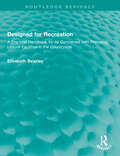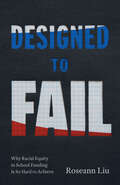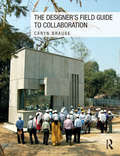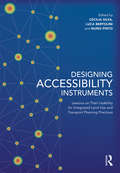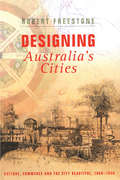- Table View
- List View
The Design of Frontier Spaces: Control and Ambiguity (Design and the Built Environment)
by Andreas Luescher Carolyn LoebIn a globalizing world, frontiers may be in flux but they remain as significant as ever. New borders are established even as old borders are erased. Beyond lines on maps, however, borders are spatial zones in which distinctive architectural, graphic, and other design elements are deployed to signal the nature of the space and to guide, if not actually control, behaviour and social relations within it. This volume unpacks how manipulations of space and design in frontier zones, historically as well as today, set the stage for specific kinds of interactions and convey meanings about these sites and the experiences they embody. Frontier zones organize an array of functions to facilitate the passage of goods, information, and people, and to define and control access. Bringing together studies from Asia, Africa, the Middle East, Europe, and North America, this collection of essays casts a wide net to consider borders of diverse sorts. Investigations of contemporary political frontiers are set within the context of examinations of historical borders, borders that have existed within cities, and virtual borders. This range allows for reflection on shifts in how frontier zones are articulated and the impermanence of border emplacements, as well as on likely scenarios for future frontiers. This text is unique in bringing together a number of scholarly perspectives in the arts and humanities to examine how spatial and architectural design decisions convey meaning, shape or abet specific social practices, and stage memories of frontier zones that no longer function as such. It joins and expands discussions in social science disciplines, in which considerations of border practices tend to overlook the role of built form and material culture more broadly in representing social practices and meanings.
The Design of the Eurosystem's Monetary Policy Instruments (Contributions to Economics)
by Ulrike NeyerThe creation of a single monetary currency and a single monetary policy in the euro area has faced extraordinary challenges, among them the design of suitable monetary policy instruments. This book evaluates monetary policy instruments of the Eurosystem against a number of requirements. To do so, a theoretical model framework is developed which brings together the monetary policy activities of a central bank and the liquidity management of banks considering the main characteristics and institutional features of the euro area.
The Design of Urban Manufacturing
by Robert N. Lane Nina RappaportAmerican cities are rediscovering the economic and social value of urban manufacturing. However, urban manufacturing is often invisible and poorly understood in terms of urban design, architecture, and policy. The Design of Urban Manufacturing brings a multidisciplinary approach to a new complex reality that urban manufacturing now sits squarely at the intersection of research, education, and neighborhood revitalization. Using cases studies from across North America and beyond, this book presents innovative approaches not only to the design of districts and buildings, but to the design of policy as well: the special roles that governments, local development corporations, and not-for-profit organizations all have to play in supporting manufacturing. This book presents current models for working neighborhoods where factories enable fine-grained, mixed-use communities and face-to-face contact while creatively solving the very real problems of goods movement and functional buildings. Design guidelines and policy recommendations are calibrated to different types of production districts. The Design of Urban Manufacturing is the essential resource for policy makers, designers, and students in urban design, planning, and urban and economic development.
The Design of Urban Manufacturing
by Robert N. Lane Nina RappaportAmerican cities are rediscovering the economic and social value of urban manufacturing. However, urban manufacturing is often invisible and poorly understood in terms of urban design, architecture, and policy. The Design of Urban Manufacturing brings a multidisciplinary approach to a new complex reality that urban manufacturing now sits squarely at the intersection of research, education, and neighborhood revitalization. Using cases studies from across North America and beyond, this book presents innovative approaches not only to the design of districts and buildings, but to the design of policy as well: the special roles that governments, local development corporations, and not-for-profit organizations all have to play in supporting manufacturing. This book presents current models for working neighborhoods where factories enable fine-grained, mixed-use communities and face-to-face contact while creatively solving the very real problems of goods movement and functional buildings. Design guidelines and policy recommendations are calibrated to different types of production districts. The Design of Urban Manufacturing is the essential resource for policy makers, designers, and students in urban design, planning, and urban and economic development.
Design Out Crime
by Ian ColquhounHere is a book about the practical design of communities and housing in which people can enjoy a good quality of life, free from crime and fear of crime.Recognising that crime, vandalism and anti-social behaviour are issues of high public concern, and that the driving forces behind crime are numerous, this book argues that good design can help tackle many of these issues. It shows how, through integrating simple crime prevention principles in the design process, it is possible, almost without notice, to make residential environments much safer.Written from the perspective of an architect and town planner, this book offers practical design guidelines through a set of accessible case studies drawn from the UK, USA, The Netherlands and Scandinavia. Each example illustrates how success comes when design solutions reflect local characteristics and where communities are truly sustainable; where residents feel they belong, and where crime is dealt with as part of the bigger picture of urban design.
Design Out Crime
by Ian ColquhounHere is a book about the practical design of communities and housing in which people can enjoy a good quality of life, free from crime and fear of crime.Recognising that crime, vandalism and anti-social behaviour are issues of high public concern, and that the driving forces behind crime are numerous, this book argues that good design can help tackle many of these issues. It shows how, through integrating simple crime prevention principles in the design process, it is possible, almost without notice, to make residential environments much safer.Written from the perspective of an architect and town planner, this book offers practical design guidelines through a set of accessible case studies drawn from the UK, USA, The Netherlands and Scandinavia. Each example illustrates how success comes when design solutions reflect local characteristics and where communities are truly sustainable; where residents feel they belong, and where crime is dealt with as part of the bigger picture of urban design.
The Design Politics of the Passport: Materiality, Immobility, and Dissent
by Mahmoud KeshavarzThe Design Politics of the Passport presents an innovative study of the passport and its associated social, political and material practices as a means of uncovering the workings of 'design politics'. It traces the histories, technologies, power relations and contestations around this small but powerful artefact to establish a framework for understanding how design is always enmeshed in the political, and how politics can be understood in terms of material objects.Combining design studies with critical border studies, alongside ethnographic work among undocumented migrants, border transgressors and passport forgers, this book shows how a world made and designed as open and hospitable to some is strictly enclosed, confined and demarcated for many others - and how those affected by such injustices dissent from the immobilities imposed on them through the same capacity of design and artifice.
The Design Politics of the Passport: Materiality, Immobility, and Dissent
by Mahmoud KeshavarzThe Design Politics of the Passport presents an innovative study of the passport and its associated social, political and material practices as a means of uncovering the workings of 'design politics'. It traces the histories, technologies, power relations and contestations around this small but powerful artefact to establish a framework for understanding how design is always enmeshed in the political, and how politics can be understood in terms of material objects.Combining design studies with critical border studies, alongside ethnographic work among undocumented migrants, border transgressors and passport forgers, this book shows how a world made and designed as open and hospitable to some is strictly enclosed, confined and demarcated for many others - and how those affected by such injustices dissent from the immobilities imposed on them through the same capacity of design and artifice.
Design/Repair: Place, Practice & Community
by Eleni Kalantidou Guy Keulemans Abby Mellick Lopes Niklavs Rubenis Alison GillThis collection of essays sheds light on repair as a disposition to material culture and a practice rooted in diverse sociocultural experiences. It provides an in-depth exploration of how repair manifests itself through the different lenses of governance, grassroots activism, transformative design and community-led initiatives. Most importantly, the chapters demonstrate how place-based approaches can reveal blueprints for social impact in circumstances of growing environmental and social precariousness.
Design Review: Challenging Urban Aesthetic Control (Routledge Revivals Ser.)
by Brenda C. Scheer Wolfgang F.E. PreiserThat the topic ofdesign review is somehow trou My biases are clearfrom the start: I am among blesome is probably one thing all readers can those who believe that, despite all signals to the contrary, the physical structure of our environ agree on. Beyond this, however, I suspect pros pects of consensus are dim. Differing opinions ment can be managed, and that controlling it is on the subject likely range from those desiring the key to the ameliorationofnumerous problems control tothosedesiringfreedom. Saysonecamp: confronting society today. I believe that design our physical and natural environments are going can solve a host ofproblems, and that the design to hell in a hand basket. Says the other: design of the physical environment does influence be review boards are only as good as their members; havior. more often than not their interventions produce Clearly, this is a perspective that encompasses mediocre architecture. more than one building at a time and demands As a town planner and architect, I am sympa that each building understand its place in a larger thetic to the full range of sentiment. Perhaps a context-the city. Indeed, anyone proposing discussion of these two concepts-control and physical solutions to urban problems is designing freedom-and their differences would now be or, as may seem more often the case, destroying useful. But let me instead suggest that both posi the city.
Designated Drivers: How China Plans to Dominate the Global Auto Industry
by G. E. AndersonAn in-depth look at the Chinese car industry that sheds new light on the delicate nature of China's planned economy China's unprecedented growth over the last three decades, along with the recent financial crisis in the West, has raised questions about the superiority of state-led capitalism. In Designated Drivers: How China Plans to Dominate the Global Auto Industry, G.E. Anderson, a specialist in finance and Chinese political economics, uses the auto industry to examine how China's industrial planning works, and explores whether state involvement in the economy really is a winning formula for sustainable growth. Bringing to light the strengths and weaknesses that define the Chinese economy, Anderson finds that in some ways the government has become its own worst enemy, unable to choose between industrial competitiveness and social stability. While the economy is booming now, evidence suggests that long-term success is far from assured. Tracing the evolution of the post-Mao auto industry through thirteen case studies, Designated Drivers raises the difficult questions about the future of China that few people have dared to ask. Offers a unique insight into the Chinese economy through the lens of the auto industry Explores how successful the central government has been in spurring economic growth and the long-terms costs of intervention Uses case studies to illustrate China's explosive growth over the last three decades A painstakingly researched analysis of the Chinese automobile industry, Designated Drivers explains the risks and rewards inherent in doing business in China that anyone interested in, or already working there need to understand.
Designated Drivers: How China Plans to Dominate the Global Auto Industry
by G. E. AndersonAn in-depth look at the Chinese car industry that sheds new light on the delicate nature of China's planned economy China's unprecedented growth over the last three decades, along with the recent financial crisis in the West, has raised questions about the superiority of state-led capitalism. In Designated Drivers: How China Plans to Dominate the Global Auto Industry, G.E. Anderson, a specialist in finance and Chinese political economics, uses the auto industry to examine how China's industrial planning works, and explores whether state involvement in the economy really is a winning formula for sustainable growth. Bringing to light the strengths and weaknesses that define the Chinese economy, Anderson finds that in some ways the government has become its own worst enemy, unable to choose between industrial competitiveness and social stability. While the economy is booming now, evidence suggests that long-term success is far from assured. Tracing the evolution of the post-Mao auto industry through thirteen case studies, Designated Drivers raises the difficult questions about the future of China that few people have dared to ask. Offers a unique insight into the Chinese economy through the lens of the auto industry Explores how successful the central government has been in spurring economic growth and the long-terms costs of intervention Uses case studies to illustrate China's explosive growth over the last three decades A painstakingly researched analysis of the Chinese automobile industry, Designated Drivers explains the risks and rewards inherent in doing business in China that anyone interested in, or already working there need to understand.
Designed for Recreation: A Practical Handbook for All Concerned with Providing Leisure Facilities in the Countryside (Routledge Revivals)
by Elisabeth BeazleyOriginally published in 1969, at a time when there was an ever-increasing number of people going to the coast and countryside at weekends and on holiday, this book filled a gap by providing detail on the physical results of all that needed to be done for the leisure-seeking public. It discusses juggling the needs of the public whilst maintaining the quality of the natural environment – a balancing act which remains as relevant in the 21st Century as when the book was first published. The book is intended for all those making provision for public recreation and countryside protection. The passing of the Countryside Act in 1968 in the UK necessitated detailed work for local authorities: the design and siting of car parks; public lavatories; litter bins, camp and picnic sites; swimming pools and information centres to name but a few. Elisabeth Beazley discusses the principles involved and illustrates successful and cautionary examples from both sides of the Atlantic as well as Continental Europe
Designed for Recreation: A Practical Handbook for All Concerned with Providing Leisure Facilities in the Countryside (Routledge Revivals)
by Elisabeth BeazleyOriginally published in 1969, at a time when there was an ever-increasing number of people going to the coast and countryside at weekends and on holiday, this book filled a gap by providing detail on the physical results of all that needed to be done for the leisure-seeking public. It discusses juggling the needs of the public whilst maintaining the quality of the natural environment – a balancing act which remains as relevant in the 21st Century as when the book was first published. The book is intended for all those making provision for public recreation and countryside protection. The passing of the Countryside Act in 1968 in the UK necessitated detailed work for local authorities: the design and siting of car parks; public lavatories; litter bins, camp and picnic sites; swimming pools and information centres to name but a few. Elisabeth Beazley discusses the principles involved and illustrates successful and cautionary examples from both sides of the Atlantic as well as Continental Europe
Designed to Fail: Why Racial Equity in School Funding Is So Hard to Achieve
by Roseann LiuA provocative examination of how systemic racism in education funding is sustained. For people who care about urban school districts like Philadelphia’s, addressing the challenges that these schools face often boils down to the need for more money. But why are urban districts that serve Black and Brown students still so perennially underfunded compared to majority-white ones? Why is racial equity in school funding so hard to achieve? In Designed to Fail, Roseann Liu provides an inside look at the Pennsylvania state legislature and campaigns for fair funding to show how those responsible for the distribution of school funding work to maintain the privileges of majority-white school districts. Liu analyzes how colorblind policies, political structures, and the maintenance of the status quo by people in power perpetuate wide and deepening racial disparities in education funding. Taking a lesson from community organizers fighting for a racially equitable school funding system, Liu’s work is a bold call to address structural racism at the root and organize from a place of abundant justice.
Designer Politics: How Elections Are Won
by Margaret ScammellThis is the first book to offer a serious examination of the phenomenon of political marketing in Britain. It presents an analysis of the increasingly influential role of the image-makers and casts a critical eye over the debate concerning the impact of marketing on political conduct and governance. Its primary focus is party and government communications in the Thatcher era and beyond, up to and including the 1992 general election. It argues that Thatcher, despite her image as the resolute politician, pioneered marketing techniques and concepts which have since become standard practice. Designer Politics looks at the historical engines of growth of commercial salesmanship in politics. It explores how political culture and conduct have been affected by the phenomenon and to what extent politics and policy have been remoulded to fit the marketing process. The author challenges the prevailing pessimism that Britain is hurtling towards American presidential-style campaigns and that marketing necessarily demeans and undermines democracy. While there are inherent dangers, there also comes new potential for a more genuinely popular democracy.
The Designer's Field Guide to Collaboration
by Caryn BrauseThe Designer’s Field Guide to Collaboration provides practitioners and students with the tools necessary to collaborate effectively with a wide variety of partners in an increasingly socially complex and technology-driven design environment. Beautifully illustrated with color images, the book draws on the expertise of top professionals in the allied fields of architecture, landscape architecture, engineering and construction management, and brings to bear research from diverse disciplines such as software development, organizational behavior, and outdoor leadership training. Chapters examine emerging and best practices for effective team building, structuring workflows, enhancing communication, managing conflict, and developing collective vision––all to ensure the highest standards of design excellence. Case studies detail and reflect on the collaborative processes used to create award-winning projects by Studio Gang, Perkins+Will, Tod Williams Billie Tsien Architects | Partners, Gensler, CDR Studio, Mahlum Architects, In.Site:Architecture, and Thornton Tomasetti’s Core Studio. The book also provides pragmatic ideas and formal exercises for brainstorming productively, evaluating ideas, communicating effectively, and offering feedback. By emphasizing the productive influence and creative possibilities of collaboration within the changing landscape of architectural production, the book proposes how these practices can be taught in architecture school and expanded in practice. In a changing world that presents increasingly complex challenges, optimizing these collaborative skills will prove not only necessary, but crucial to the process of creating advanced architecture.
The Designer's Field Guide to Collaboration
by Caryn BrauseThe Designer’s Field Guide to Collaboration provides practitioners and students with the tools necessary to collaborate effectively with a wide variety of partners in an increasingly socially complex and technology-driven design environment. Beautifully illustrated with color images, the book draws on the expertise of top professionals in the allied fields of architecture, landscape architecture, engineering and construction management, and brings to bear research from diverse disciplines such as software development, organizational behavior, and outdoor leadership training. Chapters examine emerging and best practices for effective team building, structuring workflows, enhancing communication, managing conflict, and developing collective vision––all to ensure the highest standards of design excellence. Case studies detail and reflect on the collaborative processes used to create award-winning projects by Studio Gang, Perkins+Will, Tod Williams Billie Tsien Architects | Partners, Gensler, CDR Studio, Mahlum Architects, In.Site:Architecture, and Thornton Tomasetti’s Core Studio. The book also provides pragmatic ideas and formal exercises for brainstorming productively, evaluating ideas, communicating effectively, and offering feedback. By emphasizing the productive influence and creative possibilities of collaboration within the changing landscape of architectural production, the book proposes how these practices can be taught in architecture school and expanded in practice. In a changing world that presents increasingly complex challenges, optimizing these collaborative skills will prove not only necessary, but crucial to the process of creating advanced architecture.
Designing Accessibility Instruments: Lessons on Their Usability for Integrated Land Use and Transport Planning Practices
by Cecilia Silva Nuno Pinto Luca BertoliniThe integration of land use and transport planning is key to making cities sustainable and liveable. Accessibility can provide an effective framework for this integration. However, today there is a significant gap between the advances in scientific knowledge on accessibility and its effective application in planning practice. In order to close this gap, Designing Accessibility Instruments introduces a novel methodology for the joint assessment and development of accessibility instruments by researchers and practitioners. The book: provides a theoretical and professional analysis of the main concepts behind the definition, use and measurement of accessibility; undertakes a comprehensive inventory and critical analysis of accessibility instruments, focusing on the bottlenecks in their transposition to planning practice; introduces and applies a novel methodology for the assessment and improvement of the practical use and usefulness of accessibility instruments; presents six in-depth illustrative case study applications of the methodology, representing a range of cities with different geographical and institutional settings, and different levels of urban and transport planning integration. The book is supported by a companion website – www.accessibilityplanning.eu – which extrapolates its content to a broader scope and keeps it updated and valid with new iterations of the methodology and further advances on the initial and new case studies.
Designing Accessibility Instruments: Lessons on Their Usability for Integrated Land Use and Transport Planning Practices
by Cecilia Silva Nuno Pinto Luca BertoliniThe integration of land use and transport planning is key to making cities sustainable and liveable. Accessibility can provide an effective framework for this integration. However, today there is a significant gap between the advances in scientific knowledge on accessibility and its effective application in planning practice. In order to close this gap, Designing Accessibility Instruments introduces a novel methodology for the joint assessment and development of accessibility instruments by researchers and practitioners. The book: provides a theoretical and professional analysis of the main concepts behind the definition, use and measurement of accessibility; undertakes a comprehensive inventory and critical analysis of accessibility instruments, focusing on the bottlenecks in their transposition to planning practice; introduces and applies a novel methodology for the assessment and improvement of the practical use and usefulness of accessibility instruments; presents six in-depth illustrative case study applications of the methodology, representing a range of cities with different geographical and institutional settings, and different levels of urban and transport planning integration. The book is supported by a companion website – www.accessibilityplanning.eu – which extrapolates its content to a broader scope and keeps it updated and valid with new iterations of the methodology and further advances on the initial and new case studies.
Designing an All-Inclusive Democracy: Consensual Voting Procedures for Use in Parliaments, Councils and Committees
by Peter EmersonThis book describes the voting procedures by which majority rule may be replaced by a more consensual system of governance. In a word, such an inclusive polity can be achieved by asking the voters or, more usually, their representatives in councils and parliaments, to state their preferences, so to facilitate the identification of that option which gains the highest average preference score.
Designing and Conducting Survey Research: A Comprehensive Guide
by Louis M. Rea Richard A. ParkerThe industry standard guide, updated with new ideas and SPSS analysis techniques Designing and Conducting Survey Research: A Comprehensive Guide Fourth Edition is the industry standard resource that covers all major components of the survey process, updated to include new data analysis techniques and SPSS procedures with sample data sets online. The book offers practical, actionable guidance on constructing the instrument, administrating the process, and analyzing and reporting the results, providing extensive examples and worksheets that demonstrate the appropriate use of survey and data techniques. By clarifying complex statistical concepts and modern analysis methods, this guide enables readers to conduct a survey research project from initial focus concept to the final report. Public and nonprofit managers with survey research responsibilities need to stay up-to-date on the latest methods, techniques, and best practices for optimal data collection, analysis, and reporting. Designing and Conducting Survey Research is a complete resource, answering the "what", "why", and "how" every step of the way, and providing the latest information about technological advancements in data analysis. The updated fourth edition contains step-by-step SPSS data entry and analysis procedures, as well as SPSS examples throughout the text, using real data sets from real-world studies. Other new information includes topics like: Nonresponse error/bias Ethical concerns and special populations Cell phone samples in telephone surveys Subsample screening and complex skip patterns The fourth edition also contains new information on the growing importance of focus groups, and places a special emphasis on data quality including size and variability. Those who employ survey research methods will find that Designing and Conducting Survey Research contains all the information needed to better design, conduct, and analyze a more effective survey.
Designing and Conducting Survey Research: A Comprehensive Guide
by Louis M. Rea Richard A. ParkerThe industry standard guide, updated with new ideas and SPSS analysis techniques Designing and Conducting Survey Research: A Comprehensive Guide Fourth Edition is the industry standard resource that covers all major components of the survey process, updated to include new data analysis techniques and SPSS procedures with sample data sets online. The book offers practical, actionable guidance on constructing the instrument, administrating the process, and analyzing and reporting the results, providing extensive examples and worksheets that demonstrate the appropriate use of survey and data techniques. By clarifying complex statistical concepts and modern analysis methods, this guide enables readers to conduct a survey research project from initial focus concept to the final report. Public and nonprofit managers with survey research responsibilities need to stay up-to-date on the latest methods, techniques, and best practices for optimal data collection, analysis, and reporting. Designing and Conducting Survey Research is a complete resource, answering the "what", "why", and "how" every step of the way, and providing the latest information about technological advancements in data analysis. The updated fourth edition contains step-by-step SPSS data entry and analysis procedures, as well as SPSS examples throughout the text, using real data sets from real-world studies. Other new information includes topics like: Nonresponse error/bias Ethical concerns and special populations Cell phone samples in telephone surveys Subsample screening and complex skip patterns The fourth edition also contains new information on the growing importance of focus groups, and places a special emphasis on data quality including size and variability. Those who employ survey research methods will find that Designing and Conducting Survey Research contains all the information needed to better design, conduct, and analyze a more effective survey.
Designing Australia's Cities: Culture, Commerce and the City Beautiful, 1900�1930
by Robert FreestoneAccessible and comprehensive, written by the current President of the International Planning History Society, this volume provides readers with a highly visual account of historical, contemporary and international projects.Looking at the ways in which the City Beautiful movement influenced the design and development of Australian cities, this pioneering national study surveys the ruling ideas, influences, outcomes and enduring legacies of the early artistic turn in Australian urban design. With the return of the American City Beautiful movement to the forefront of urban design, Designing Australia’s Cities is a relevant account of the ways in which this movement influenced and shaped Australian city design, but more importantly sheds light on a planning culture that stretches far beyond Australia and is of increasing relevance worldwide today.Laying bare an important design and reform movement, whose under-appreciated legacy is clearly evident in urban landscapes today, this book is ideal for students of planning, architecture, urban design and the history of planning.
Designing Australia's Cities: Culture, Commerce and the City Beautiful, 1900�1930 (Planning, History And Environment Ser.)
by Robert FreestoneAccessible and comprehensive, written by the current President of the International Planning History Society, this volume provides readers with a highly visual account of historical, contemporary and international projects.Looking at the ways in which the City Beautiful movement influenced the design and development of Australian cities, this pioneering national study surveys the ruling ideas, influences, outcomes and enduring legacies of the early artistic turn in Australian urban design. With the return of the American City Beautiful movement to the forefront of urban design, Designing Australia’s Cities is a relevant account of the ways in which this movement influenced and shaped Australian city design, but more importantly sheds light on a planning culture that stretches far beyond Australia and is of increasing relevance worldwide today.Laying bare an important design and reform movement, whose under-appreciated legacy is clearly evident in urban landscapes today, this book is ideal for students of planning, architecture, urban design and the history of planning.









